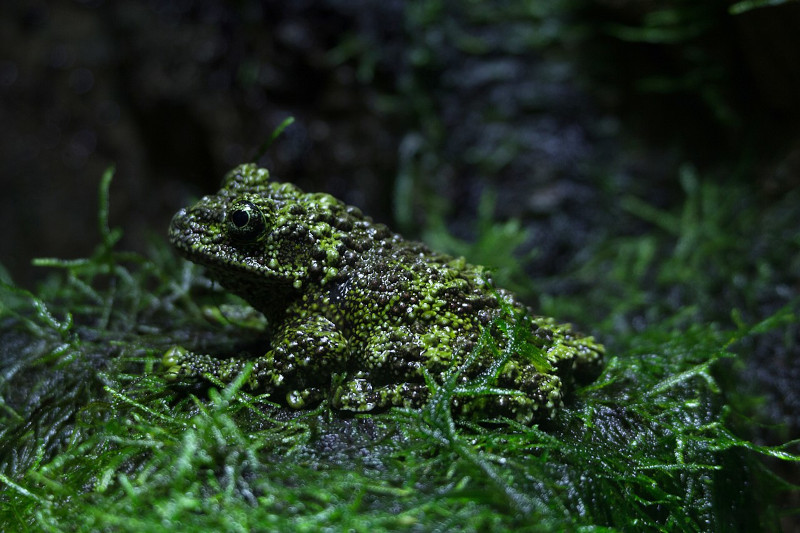Vietnamese Mossy Frog Facts
- The simultaneously descriptive and accurate term of Vietnamese Mossy Frog serves as one of the common names for a remarkable amphibian. This marvel of Nature also goes by several alternate names, though, including the distintive mossy frog, and Tonkin bug-eyed frog.
- Within the scientific community, however, it typically remains better known by its technical designation. Unfortunately, that’s a title that ranks as extremely difficult for the layperson to pronounce. That’s because this marvel holds the formal tag Theloderma corticale
- It received that tongue-twisting epithet due to the efforts of George Albert Boulenger. That highly respected Belgian-British zoologist accomplished the first official recognition of it as a separate and distinct species. He achieved that scientifically noteworthy deed in the year 1903.
- Fortunately, this marvel of Nature and evolution appears to be maintaining a sufficient and stable population base. This also seems to hold true throughout the entirety of its natural range. While its numbers do appear stable for the moment, it nonetheless has a limited range.
- But, despite the limitations this situation naturally impose, the IUCN currently list the Vietnamese Mossy Frog as Least Concern. This status appears on the organization’s Red List of Threatened Species. This presently pleasant situation remains subject to change, however.
- That’s due to the fact that it now faces several threats to its continued existence as a species. Loss of habitat, due to deforestation, obviously poses a serious danger, along with the international pet trade, regrettably. Its greatest threat, though, likely consists of climate change.
Related Articles
Vietnamese Mossy Frog Physical Description
The remarkable Vietnamese Mossy Frog never fails to capture the immediate attention and interest of those individuals fortunate enough to encounter it. It usually does so, however, due much more to its surprising appearance than physical dimensions. That’s because it’s an average-sized frog.
It also follows a pattern of development common among its many kindred around the world. That’s the fact that it displays a certain degree of the physiological characteristic of sexual dimorphism. In its specifc case, though, that trait manifests itself solely in terms of simple physical dimensions.
Overall, the species achieves an average body length equaling approximately 2.5 – 3 in (6 – 8 cm). Females generally stand on the higher end of this range, while males of the species usually sit on the lower end. In both genders, though, the body develops as stocky in form, and with short limbs.
Yet, it’s doubtless the astonishing texture of the skin itself of the aptly-named Vietnames Frog that typically garners the most attention. Serving as the source of the major common name, this presents a dense covering of bumpy, warty projections that supposedly resemble moss, lichen, or algae.
Meanwhile, this wonder of the animal kingdom also evolved a pattern of coloring that only further serves to enhance that resemblance. This most frequently consists of a moderately mottled mixture of dark green, black, and brown. Incredibly, even occasional reddish or pinkish hues manifest.
Its other natural features also merit their own share of attention from observers. The eyes develop atop the head, and on the sides. Nature created these as relatively large in size and protruding, with horizontal pupils. The feet of this remarkable creature even possess slightly expanded toe pads.
- Kingdom: Animalia
- Phylum: Chordata
- Class: Amphibia
- Order: Anura
- Family: Rhacophoridae
- Genus: Theloderma
- Species: T. corticale
Vietnamese Mossy Frog Distribution, Habitat, and Ecology
Most lamentably for those among us who appreciate the myriad wonders of Nature, the fantastic Vietnamese Mossy Frog only inhabits a small area of the world’s surface. More precisely, as the name implies, it mainly exists in the northern portions of the country of Vietnam, in Asia.
Unconfirmed reports of small populations in other surrounding regions nonetheless exist, though. These other locations include the province of Hainan, in China, and possibly Laos. Wherever the animal makes an appearance, though, it displays decided preferences for its choice of habitat.
Being semi-aquatic in nature, it requires a nearby source of water. But that’s only the beginning of its habitat needs. Very specifically, the amphibian has only been seen by observers on the banks of mountain streams situated at elevations of approximately 3,000 ft (9.842 ft), or in flooded caves.
This truly fascinating animal evolved, like many of its brethren found across the globe, as nocturnal in its nature. It’s also fully insectivorous in its dietary habits. The remarkable frog primarily consumes larger insects, such as crickets, cockroaches, and moths, but will feed opportunistically.
Intriguingly, the breeding patterns of the Vietnamese Mossy Frog also seems to be quite specific. This activity mainly takes place in partially flooded rock cavities. The female typically lays a clutch of 8 – 10 eggs, placed just above the water. These generally hatch over a period of 7 – 14 days.
After hatching, the numerous newborns instinctively quickly drop into the water waiting below them. The ensuing metamorphosis from a tadpole into a fully mature frog typically requires around 3 months. The exact lifespan of the frog in the wild is unknown, but estimates place it at 10 years.
Species Sharing Its Range
Check out our other articles on Spinetail mobula, Ol Doinyo Lengai, Happy Face Spider, Blood Falls, 7 Bizarre and Unusual Birds, Spiny Flower Mantis, East African Lowland Honey Bee

